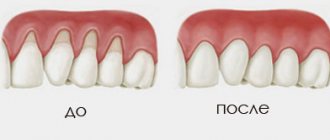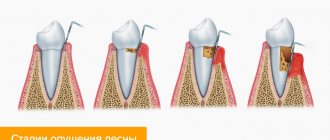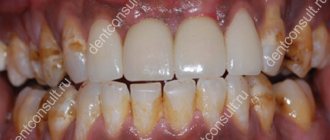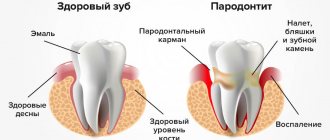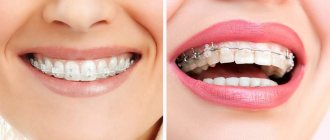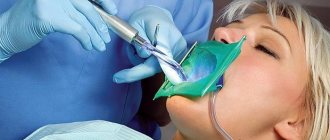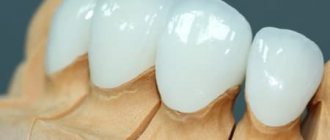Even patients who feel a panicky fear of visiting a dental office still turn to a dentist for help when they experience a piercing toothache caused by inflammation of the dental tissues. But inflammation of the gums near the tooth, which occurs without significant pain, usually remains unattended. Patients get used to its symptoms very quickly, not considering them a serious reason to go to the clinic.
Meanwhile, a separate section in dentistry deals with the study and treatment of gum diseases - periodontology. Periodontium is the complex of tissues surrounding the tooth, including, in addition to the gums, the bone tissue of the alveolus - the gingival socket, the periodontium connecting it to the tooth root, and the cementum of the tooth root.
According to statistics, patients in dental clinics much more often lose teeth not from caries, but from periodontal diseases, which are treated by a periodontist.
Who is a periodontist and what does he do?
So, answering the question of who a periodontist is and what he treats, you must immediately indicate that this is a doctor who deals with the oral mucosa, as well as bone tissue and periodontal ligaments. The soft tissues that surround the teeth and securely hold them in place are quite often subject to inflammatory and dystrophic lesions. If not treated promptly, the periodontal ligaments weaken, which can ultimately lead to tooth loss. A specialist in the field in question is engaged in the study, prevention and treatment of diseases that affect the periodontium and sometimes spread to the jaw bone.
A periodontist is a narrower specialist than a dental therapist.
If we talk about how a periodontist differs from a dental therapist, then we need to clarify that we are talking about a more specialized specialist. He treats pathologies such as gingivitis, periodontitis, periodontal disease and other periodontal disorders. To avoid such problems, you need to visit the dentist twice a year. If suspicious symptoms are detected, he will redirect the patient to a specialized expert.
Periostitis is an inflammatory process in the area of the periosteum with the subsequent appearance of purulent foci between the periosteum and the bone.
Periostitis, as a rule, occurs as a complication of periodontitis and manifests itself in the form of significant swelling of soft tissues, characterized by pain and significant changes in the general condition of the body. To eliminate periostitis, emergency surgery is required.
What functions does periodontal tissue perform?
Periodontal tissues perform 4 important functions:
- They serve as a support for the teeth, holding them firmly in the socket, and, due to the presence of collagen fibers, they cushion, evenly distributing the load when chewing food.
- They protect the tooth root from the penetration of pathogenic microflora, which can cause severe inflammation and significant pain.
- Due to the branched capillary network, blood microcirculation is ensured in accordance with the chewing load.
- They reflexively regulate chewing pressure due to nerve endings - receptors.
Periodontal tissues are easily injured by tartar, hot foods and drinks, spicy foods, toothpicks, etc., and the oral cavity is constantly home to several hundred varieties of pathogenic microorganisms. Therefore, the consequences of injuries are infectious inflammatory diseases - gingivitis and periodontitis. Gum inflammation often has a long course and leads to serious disruptions in the functioning of the digestive, endocrine and cardiovascular systems.
In addition, every third to fifth periodontist patient suffers from periodontal disease, a dystrophic disease that also leads to gum atrophy, the causes of which are still unclear.
Diseases treated by a periodontist
Now let’s look at what exactly a periodontist does and what he treats. People turn to this specialist primarily for problems with gums. Here are the most common pathologies within his area of expertise:
- gingivitis is an inflammation of the gums, which usually precedes any pathological process that penetrates deeper into the soft tissue. In this case, the mucous membrane turns red, swells, pain and bleeding appear,
The photo shows gingivitis - Periodontitis is a deeper and more serious inflammatory disease that leads to functional changes in the periodontium, causing severe pain, especially during meals. Bleeding becomes more intense, and in advanced stages teeth begin to loosen, which can ultimately lead to their complete loss,
The photo shows advanced periodontitis - periodontal disease - the disease itself is a non-inflammatory pathology in which degenerative processes occur in the soft tissues. The cause of the development of the disease is usually internal disorders, including those related to the functioning of the endocrine system. Gum recession is observed, the necks of the teeth are exposed, and their mobility appears. But in some cases, this term refers to an advanced stage of periodontitis, when, if left untreated, the infection penetrates deeper into the tissue and provokes even more serious structural changes.
This is what periodontal disease looks like
“Based on my life experience, I can only recommend visiting a periodontist at least once a year. All my life I have taken care of my health, brushed my teeth, and never developed caries. And then, at the age of 45, I was diagnosed with periodontal disease! Nothing hurt, my gums didn’t bleed, and the therapist didn’t notice anything. And if I had gone to a periodontist at least once, they could have noticed and slowed down the process...”
Lyudmila V.D., Nizhny Novgorod, from correspondence on the forum www.32top.ru
- root cyst - in this case, the help of a periodontist may also be required, since the pathological phenomenon leads to a pronounced weakening of the ligaments. The neoplasm usually develops without pronounced symptoms, but over time, aching pain occurs in the depths of the gums, swelling appears and the mucous membrane turns red. More often it occurs due to infection entering the tissue, which causes the formation of a cavity with fluid. In the acute stage, it can develop into periostitis, a purulent abscess, and therefore requires mandatory treatment,
- stomatitis is an infectious lesion of the oral mucosa, which is the result of the penetration of a bacterial infection into the tissue, often through wounds and minor injuries. A fungal infection can also cause the development of pathology, and in this case we will be talking about candidal stomatitis. Usually the disease manifests itself in the form of redness and soreness of the mucous membrane, itching and burning, and the formation of ulcers in the mouth.
The photo shows a fungal infection
This is not a complete list of possible pathological conditions in which one cannot do without the help of a professional periodontist - he treats completely independently or involves a therapist/surgeon to help, it all depends on the situation.
But if you discover unpleasant symptoms such as swelling of the gums, pain and bleeding, you can immediately contact a specialized specialist or a dental therapist, who, if necessary, will give the necessary referral.
What diseases does a periodontist treat?
The list of diseases is quite short, but everyone knows the importance of oral health. So:
- Gingivitis. This disease manifests itself in the form of periodontal inflammation and is divided into several types. With the ulcerative form, painful growths appear on the gums. With the fibrous form of gingivitis, the gums grow, causing pain to the patient.
- Periodontitis. This disease causes the following symptoms: itching, discoloration of gums, bleeding.
- Periodontal disease. This is the name for complications that occur without proper treatment of periodontitis. The extreme stage is purulent discharge and tooth loss.
- Cyst. If the infection gets into the root canals of the teeth, then formations appear on the periodontium. Treatment requires not only a periodontist, but also a surgeon.
It is important to prevent the occurrence of the above diseases and take care of the health of your gums.
Three stages can be identified in a doctor’s actions:
- Elementary. The patient is examined, tests are collected and a diagnosis is made.
- Surgical. This stage can be bypassed; if the disease is not advanced, then the specialist moves on to prevention. But in the worst case scenario, surgical intervention is required.
- Prophylactic. The best outcome will be one in which a specialist will examine the oral cavity and prevent the appearance of further symptoms and the spread of infection, which will be the end of your acquaintance with this doctor.
When to ask for help
So, we figured out what a periodontist is – what kind of doctor he is in dentistry and what exactly he does. Now let's move on to specific cases in which his help may be required. You need to make an appointment with a specialist if the following symptoms appear:
- the gums “sag”, exposing the necks of the teeth, which is why the crowns seem to lengthen,
- bleeding occurs - traces of blood can be found while brushing your teeth or when biting into hard foods,
- unpleasant odor from the mouth,
- swelling of the mucous membrane, pain,
- the appearance of suspicious neoplasms - wounds, pimples, ulcers, bumps,
- discharge of fluid from the gums,
- increased sensitivity to temperature changes in food,
- pathological mobility of teeth.
If the mucous membrane becomes looser, the tissues turn red and swell, then this is a reason to consult a specialist.
You cannot delay visiting a doctor - the longer you ignore the symptoms, the closer you are to the risk of losing teeth. A timely diagnosis will prevent further development of the disease and its complications.
What symptoms should be considered for periodontal disease?
Initially, periodontitis may develop without visible symptoms, so regular dental examinations are essential for early diagnosis.
The main symptoms of periodontitis are redness and swelling of the gums, which begin to pull away from the teeth, forming pockets. This often results in increased tooth sensitivity, a feeling of pressure between the teeth, or bleeding when brushing or flossing.
In later stages, you may develop gum recession, root caries, suppuration between the teeth and gums, loose teeth, or complete tooth loss.
| Mild periodontitis | Moderate periodontitis | Severe periodontitis |
How does an appointment with a specialist work?
As for where the periodontist works, the answer is obvious - in dentistry. We’ll talk about how to choose a good specialist later in this article, but for now let’s move on to the question of what a periodontist does at an appointment. First, the specialist conducts a visual examination and, if necessary, sends the patient for diagnostic procedures.
The degree of tissue damage is assessed, and if in the initial stages the pathology is usually treated with anti-inflammatory therapeutic methods, then in advanced stages more radical measures can be used, including surgery. So what procedures does a periodontist do? Each individual case requires its own technique, so it is quite difficult to come up with a universal treatment plan.
Professional hygiene is mandatory - it is necessary to remove plaque and tartar, which often provoke gum inflammation. If there are periodontal pockets, closed or open curettage (cleaning) is prescribed, depending on the depth. It can be performed using a laser, which facilitates the procedure and increases its effectiveness.
This is how open curettage is performed on the mucous membrane
In case of pronounced structural changes, gum plastic surgery is required: gingivectomy or vestibuloplasty. In the first case, excess overgrown tissue is removed, in the second, part of the mucous membrane taken from other parts of the patient’s oral cavity is “replanted” (in case of gum recession). If pathological mobility occurs, the teeth are splinted using fiberglass, polyethylene or silk thread. If some of the patient’s teeth are missing, you can consider the option of installing a clasp denture with a splinting effect for the remaining mobile teeth.
Types of gingivoplasty
Gum plastic surgery is usually performed at the end of flap operations , which end with the closure of gum defects in the neck and root of the tooth with periodontal flaps.
The second type of gingivoplasty is a delayed surgical intervention, which is performed after the gums have completely healed.
And depending on the scope of gum treatment, there are operations performed on a general basis , on all (or almost all) teeth, or on a localized area.
Tips for choosing a good periodontist
In your search for a good, experienced specialist, reviews from real patients will help you - you can find them on the Internet or ask your friends for recommendations. When choosing a doctor, you should pay attention to the following points:
- length of service and work experience,
- status of the dental clinic,
- availability of modern equipment in the institution,
- variety of services offered.
It’s good if the specialist has a certificate of advanced training in “periodontology”, and it’s better than the state standard. This is confirmation that the doctor has completed specialized courses lasting at least 144 hours and has a specialized education.
Choose a specialist responsibly
It is important that the doctor is able to find a common language with the patient, win him over, and inspire confidence. To do this, you should pay attention to his communication skills, sincere interest in the problem and its solution. The psychological aspect actually plays an important role when choosing a doctor, although many do not attach much importance to it.
Treatment of gums in children
Medicines prescribed by a doctor have analgesic, antibacterial and anti-inflammatory effects. They help restore the proper condition of the mucous membrane. Methods of using drugs are different, but the principle is the same: rinsing, irrigation.
For gum disease in infants, the dentist will prescribe special gels to relieve symptoms, namely itching and pain. Parents should pay special attention to cleaning their mouths from food debris.
Antibiotics are prescribed by a dentist in rare cases. Indications for the use of antibiotics is a form that reaches a complex (ulcerative-necrotizing gingivitis) or chronic stage. Antibacterial or antifungal drugs are prescribed when the problem is caused by an infectious process, and the goal is to eliminate its causative agent.
How is diagnostics carried out?
As part of the diagnosis, a visual examination of the oral cavity is first performed. Next, the doctor refers the patient to the necessary examinations. Let's look at the activities that may be required to make an accurate diagnosis:
- interviewing the patient regarding complaints, current condition, past and possible chronic diseases,
- examination of the oral cavity, search for foci of caries and inflammation, assessment of the volume of dental plaque. By palpation, that is, feeling, the doctor assesses the condition of the gums and lymph nodes,
- examination of inflamed areas - assessment of the degree of bleeding and swelling, possible signs of atrophic processes,
- cytological and microbiological analyzes of microflora,
- determining the depth of periodontal pockets - allows you to identify the stage of periodontitis (mild - up to 3.5 mm, medium - up to 4-5 mm, severe - more than 5 mm),
- X-ray examination, functional diagnostics,
- collection of blood tests if necessary.
For examination, you may need to take blood tests.
In each individual clinical case, a set of diagnostic procedures is selected individually. The periodontist must carefully examine the current condition of the oral tissues and take into account all associated factors in order to make an accurate diagnosis and prescribe the necessary treatment.
Causes of gum inflammation in children
- Skipping or poor quality teeth brushing;
- Sucking dirty objects;
- Errors when installing seals;
- Pathologies of the dentition;
- Carious cavities with sharp edges;
- Bite correction;
- Breathing through the mouth;
- Abnormal structure of the oral cavity organs (attachment of the frenulum of the tongue and lips);
- Problems with the functioning of the cardiovascular system;
- Disruption of the gastrointestinal tract;
- Infectious diseases (ARVI, influenza);
- Hormonal abnormalities;
- Hereditary anomalies.
How are some periodontal diseases treated?
The main thing that a periodontist does is examine periodontal tissues, prescribe and carry out treatment procedures. Moreover, the methods are selected strictly individually. To get a clearer understanding of this process, consider what measures are usually used to combat the most common diseases of the soft tissues of the oral cavity.
Gingivitis – inflammation of the gums
The pathology extends to the upper layer of the mucosa, so treatment is usually quick and painless. The main thing is to start it on time to prevent the development of more serious diseases. In addition, if the acute form can be cured in 10 days, then the chronic stage requires much more time and effort.
First of all, the doctor performs a professional teeth cleaning.
To begin with, the periodontist prescribes professional cleaning to remove plaque and tartar. You will also have to adjust your diet, replace your toothbrush and, possibly, toothpaste - a specialist will help you choose the right product. To restore the mucous membrane, a gel is usually prescribed - Metrogyl Denta or, for example, Sorcoseryl. As a restorative therapy, rinsing with decoctions of medicinal herbs - sage, eucalyptus, chamomile - is recommended. Before carrying out the procedures, you should definitely consult your doctor.
Anti-inflammatory and drug therapy is carried out, vitamin complexes with a high content of vitamin C are prescribed, which helps strengthen blood vessels and the immune system in general.
Treatment of periodontitis
In this case, an integrated approach is required: taking medications orally, using antibacterial drugs, gels, rinses and baths. But first, the periodontist must remove the foci of inflammation. To do this, hardware cleaning of teeth and gum pockets is carried out using ultrasound and water-abrasive solutions (“Vector”, “Varios”). All carious lesions are eliminated. In order to restore the mucous membrane and stimulate blood circulation, special injections are performed in it, and physiotherapy is prescribed.
Using the Vector ultrasonic device, a specialist cleans gum pockets
In advanced cases, periodontitis leads to severe tooth mobility. In such a situation, they are splinted, that is, securely fixed in the desired position using the finest threads or a clasp design. If the teeth are severely damaged, the best solution would be to remove them and then implant them with prosthetics. There are one-stage technologies that involve installing a crown or prosthesis immediately after implantation of artificial roots (within 7 days), which can significantly reduce treatment.
Periodontal therapy
In this case, treatment is aimed at eliminating symptoms, since it is impossible to completely cure the disease. At the initial and middle stages, the following activities are usually carried out:
- removal of plaque and deposits, including from under the gums,
- elimination of foci of caries - with periodontal disease they are usually localized in the root region,
- splinting with threads or clasp construction,
- restoration of gums using hardware techniques, laser, physiotherapy, special massage and electrophoresis,
- flap surgery to restore the aesthetics of the gingival contour,
- rinses and baths,
- increasing the level of oral hygiene,
- treatment of concomitant diseases of the body.
Splinting is used to fix mobile teeth.
An advanced form of pathology often leads to violations of the periodontal ligaments and tooth loss. The optimal way out of the situation would be implantation with immediate loading. The prosthesis is fixed on the same day or within a week after surgery, which provides the ability to quickly restore the appearance and functionality of the jaw apparatus.
A periodontist is a dentist who specializes in the prevention, diagnosis and treatment of periodontal diseases - all tissues in which the tooth is located: jaw bones, tooth ligaments, mucous membrane.
Periodontists are experts in the treatment of oral inflammation. Only doctors who have received a certificate in therapeutic dentistry and surgical dentistry can master this narrow specialty. A periodontist treats diseases such as stomatitis, gingivitis, periodontitis, periodontal disease, and his work also includes the selection of preventive agents to prevent all these diseases in the future.
Periodontists treat people not only with incipient gum problems, but also with severe forms of gum disease (severe periodontitis and periodontal disease) or a complex medical history. Doctors offer a wide range of procedures for the treatment of gingivitis, periodontitis, and periodontal disease. They can also treat patients with severe gum problems using a range of surgical procedures.
During the first visit, the periodontist will usually review the patient's complete medical and dental history. It is extremely important to know if the patient is taking any medications or undergoing treatment that may affect the teeth and gums, such as heart disease, diabetes, or possibly pregnancy.
The periodontist examines the gums, checks the condition of the teeth and bite. To do this, the mucosal specialist uses a small measuring device called a periodontal probe and places it between the teeth and gums to determine the depth of this space. If its depth is more than 4 mm, then it is assessed as a periodontal pocket; this helps the periodontist assess the health of the gums, which, together with other research results, will allow him to choose the right treatment. An orthopantomogram or panoramic X-ray must be taken to determine the condition of the bone below the gum line. Based on the patient’s complaints, examination of the oral cavity, X-ray data and measurement results of periodontal pockets, the doctor makes a diagnosis and prescribes treatment.
Periodontal treatment can be conservative (periodontal cleaning, scaling, medications, physiotherapeutic procedures) or surgical (bone and tissue grafting using bone preparations, membranes).
When should you make an appointment with a periodontist?
Often, the treatment of patients with periodontitis and periodontal disease is undertaken by ordinary dental therapists who have read several books and attended courses on the treatment of gum inflammation. Their tactics are to maintain visible “gum health” with the help of anti-inflammatory drugs - absence of bleeding, suppuration, and reduction of bad breath. But! These methods cannot in any way affect an already formed pocket, into which food, plaque, etc. continue to fall. Therefore, relapses of the disease constantly occur, which again, in a circle, brings the patient to the doctor.
Especially as people age, more and more patients are showing signs of periodontal disease, coupled with research that points to a link between periodontal disease and other chronic diseases, periodontal treatment may require greater understanding and increased knowledge by a qualified professional. For patients with moderate or severe disease, it is better to consult a periodontist who also knows surgical treatment methods. Ask your periodontist for surgical certification! After periodontal sanitation, how should it be used?
Research has shown that effective brushing and flossing, along with regular professional dental cleanings, helps prevent tooth decay and gum disease. But sometimes, even people who are very careful about their oral hygiene cannot protect themselves from diseases such as gingivitis and periodontitis. Your dentist may recommend a visit to a gum specialist if he notices a problem. Additionally, you can talk to your periodontist about improving the appearance of your smile using some of the options of plastic surgery.
Treatment by a periodontist
Treatment with a doctor begins with an initial consultation. The doctor draws up a treatment plan.
Periodontists have a wide range of tools available to combat gum disease. Treatment usually begins with the least invasive measures, which are not surgical procedures.
- Removing plaque and tartar
- Antimicrobial drugs and the use of antiseptics for washing periodontal pockets, their treatment with anti-inflammatory gels
- Depulpation of teeth
- Using technology for splinting mobile teeth with fiberglass
- Manufacturing of removable temporary dentures for periodontal treatment
Choosing a periodontist
A great way to find a qualified periodontist is to request a referral from your general dentist. Additionally, there are several points to consider when choosing a periodontist, including:
- The length and experience of a periodontist, how long has he been working in this specialty?
- Reviews from patients (preferably whom you know personally)
- Education and/or courses completed by the periodontist? How long ago were they completed?
- What diagnosis did the periodontist make and what treatment plan did he propose? Ask about all of your periodontal treatment options and the pros and cons of each. Periodontists have different treatment philosophies. While some focus closely on treating the disease with surgery, others prefer more conservative non-surgical alternatives. Make sure you fully understand why your periodontist is recommending a particular treatment and that you agree with the proposed plan.
- What are the estimated costs of the treatments? Does your periodontist treat under compulsory medical insurance or voluntary medical insurance? In cases where dental insurance does not cover treatment costs, what forms of payment are available?
- What types of dental technology/equipment does the clinic provide?
- What medications and pain management options are offered?
- Pleasant communication and professionalism of the support staff?
- Does the doctor work alone, or is he one of many specialists in a dental practice that can provide you with comprehensive oral care?
- What types of emergency medical care are available?
How not to fall for deception and determine that a specialist is not competent?
- The doctor recommends antibiotic injections directly into the gums.
In the case of injections into the site of inflammation (for example, an antibiotic such as Lincomycin), especially in large doses, a one-time destruction of pathogenic organisms occurs, which results in the release of toxins and mediators responsible for inflammation. As a result, the formation of a large amount of these substances leads to necrosis or necrosis of the periodontium of the tooth (the muscular-ligamentous apparatus of the tooth, with the help of which the tooth is attached to the bone). As you might guess, the tooth gradually becomes looser, which may even be much greater than before treatment. Such teeth actually cannot perceive chewing pressure. The treatment method is not used in countries such as the USA, Europe, Australia, Japan or Israel - which are known for their high level of development of dentistry and medicine in general.
- Recommendations for applying applications using ointment forms of preparations.
An absolutely useless exercise due to the fact that ointments do not remain on the wet mucous membrane and are very quickly washed off with saliva. Moreover, the active substances of ointments do not penetrate deeply (through the oral mucosa), but remain on the most superficial layer - the mucosal epithelium, which is often insufficient for full treatment.
- Lack of proper oral hygiene communication and instruction.
As we have said more than once, the only reason responsible for gum inflammation is gingivitis and periodontitis. The doctor must carefully convey to the patient that improper oral care leads to an abundant accumulation of soft microbial plaque on the teeth, which subsequently forms tartar and hard supra- and subgingival dental deposits. If the doctor did not insist that hygiene is where you should start, did not select the right toothbrush, toothpaste and did not show how to use dental floss - such a doctor is worthless.
- Lack of certificate in dental surgery.
It is important to understand that complex flap operations or curettage of periodontal pockets can only be performed by an experienced dental surgeon who has the proper education, skills, experience and diploma. Highly qualified operations involving the grafting of synthetic bone or plastic surgery along the edge of the gingival margin, which is in an inflamed state, should not be carried out by a dentist, otherwise complications are guaranteed.
- State clinics.
Today, unfortunately, it is virtually impossible to receive qualified dental care - this is primarily due to the low qualifications of the staff, the lack of modern equipment and the lack of courses, lectures or trainings for doctors.
{jlcommentspro}
Specifics of children's specialists
Children also experience periodontitis. The disease is diagnosed in approximately 3-5% of young children and adolescents, although most often it develops at the age of 9-10 years1. The problem is that the tissues of the oral cavity are still immature, constantly changing and rearranging, which is why they can react sharply to the slightest inflammation. In this case, the therapy will be little different from the treatment of an adult patient. Professional hygiene and physiotherapeutic measures will be required. Sometimes the lip frenulum is corrected if it has become one of the prerequisites for the development of periodontitis. In general, an integrated approach to diagnosis and treatment is required, since the causes may also lie in systemic pathologies.
Recently, lasers have been increasingly used to correct frenulums.
Main indications for gum surgery
Gingivoplasty is performed in the following cases:
- To remove excess periodontal tissue - for example, to eliminate the so-called “shark smile”, when part of the tooth is hidden under the gum;
- To correct the smile line - in the case when the gums on different teeth are not the same in length;
- To level the height of the gum during its recession (excessive elevation), including when the neck of the tooth is exposed;
- In case of periodontal disease, when periodontal pockets can no longer be restored;
- For active prevention of root caries and periodontal diseases;
- To improve the structure of gum tissue;
- To achieve a high-quality cosmetic effect during patchwork operations.
- For orthopedic indications - for beautiful and reliable prosthetics.
- For successful prosthetics on implants.
Changes in the condition of the gums very often occur in old age - approximately 80-95% of all cases.
Also, factors such as:
- Chronic inflammation in the oral cavity (periodontitis, periodontal disease);
- Congenital structural features of the dental system (bad bite);
- Traumatic damage to the gums;
- Bad habits (chewing a pencil, etc.);
- Improper brushing of teeth;
- Errors in previous treatment or dental prosthetics, etc.
Thanks to plastic surgery, the patient has the opportunity to restore the required volume of gum tissue .
What do periodontist surgeons do?
Specialists in this profile perform operations on the soft tissues of the oral cavity. There are many types of surgical interventions, and here are just some of the possible options for flap operations:
- resection of the gum pocket,
- removal of the gum edge,
- soft tissue transplantation - “replanting” soft tissues in the area of absorbed periodontal tissues,
- restoration of bone tissue for subsequent implantation,
- gum grafting to give an aesthetically pleasing smile,
- plastic surgery of the frenulum, etc.
A periodontist deals with all kinds of gum surgery.
To avoid serious gum diseases, it is enough to carefully monitor their condition and maintain a high level of hygiene. No one is immune from problems with teeth and gums, but we can reduce any risks to the bare minimum. Remember to brush your teeth twice a day, rinse your mouth after meals, and floss. In order to be able to recognize the pathology in time and immediately begin its treatment, it is important not to miss scheduled preventive examinations at the dentist, at least twice a year.
- According to WHO.
How will the treatment take place?
First, the doctor will eliminate periodontal inflammation, preventing further infection. For tooth mobility, he stabilizes problems with splints and joints. Sometimes the patient requires dentures. After general surgical intervention, a rehabilitation process takes place, and then for six months the periodontist monitors the recovery of the patient, but more often meetings occur only during exacerbations.
To completely cure the disease, it is important to strictly follow the instructions of your doctor.
